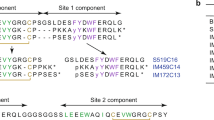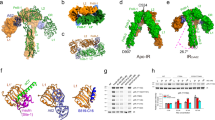Abstract
When insulin interacts with its target cells, it binds to a specific membrane receptor and triggers a chain of events which stimulate many physiological responses1,2. Although the mechanism of insulin action remains uncertain2-4, electron microscopy has suggested that unoccupied insulin receptors appear in clusters of two to six molecules and that insulin becomes internalized after binding to them5,6. Insulin receptors on 3T3 fibroblasts labelled with rhodamine–insulin (R-insulin) are diffusely distributed and mobile on the cell surface, with a lateral diffusion coefficient D∼(3–5)×10−10cm2s−1. At 37°C, hormone–receptor complexes aggregate into immobile patches which are soon endocytosed7,8. A new tool for such studies has been provided by the discovery of autoantibodies to the insulin receptor in the sera of certain patients with insulin-resistant diabetes9. These antibodies stimulate various physiological responses normally mediated by insulin10-14. Both the bivalent antibodies (Fab′)2 and the monovalent Fab′ block insulin binding, but only the bivalent antibodies are biologically active14, Fab′ acting as a competitive antagonist14. Similarly, antibodies raised against purified insulin receptors can mimic insulin15, suggesting that microaggregation of receptors could be involved in the action of this hormone14,16. We now report that at 37°C both R-insulin and the rhodamine-labelled antibodies against insulin receptors form a single cap on one pole of the cell. Cells which were first treated at 37°C with fluorescein–insulin (F-insulin, at partial receptor occupancy), fixed with formaldehyde and then treated with either R–insulin or rhodamine-labelled anti-receptor antibodies, showed overlapping caps of the two markers. These experiments demonstrate directly the aggregation of insulin receptors and suggest either that insulin receptors are multivalent towards the hormone or that the unoccupied receptors migrate together with the occupied ones in the formation of caps.
This is a preview of subscription content, access via your institution
Access options
Subscribe to this journal
Receive 51 print issues and online access
$199.00 per year
only $3.90 per issue
Buy this article
- Purchase on Springer Link
- Instant access to full article PDF
Prices may be subject to local taxes which are calculated during checkout
Similar content being viewed by others
References
Czech, M. P. A. Rev. Biochem. 46, 359 (1979).
Kahn, C. R. J. Cell Biol. 70, 261–286 (1976).
Terris, S. & Steiner, D. F. J. biol. Chem. 250, 8389–8398 (1975).
Godfine, I. D., Smith, G. J., Wong, K. Y. & Jones, A. L. Proc. natn. Acad. Sci. U.S.A. 74, 1368–1372 (1977).
Jarett, L. & Smith, R. M. J. supramolec. Struct. 6, 45–59 (1977).
Gorden, P., Carpentier, J.-L., Freychet, P., LeCam, A. & Orci, L. Science 200, 782–785 (1978).
Schlessinger, J., Shechter, Y., Cuatrecasas, Y., Willingham, M. C. & Pastan, I. Proc. natn. Acad. Sci. U.S.A. 75, 5353–5357 (1978).
Schlessinger, J., Shechter, Y., Willingham, M. C. & Pastan, I. Proc. natn. Acad. Sci U.S.A. 75, 2659–2663 (1978).
Flier, J., Kahn, C. R., Roth, J. & Bar, R. S. Science 190, 63–65 (1975).
Kahn, C. R., Baird, K. L., Flier, J. S. & Jarrett, D. B. J. clin. Invest. 60, 1094–1106 (1977).
Kasuga, M. et al. J. clin. Endocr. Metab. 47, 66–77 (1978).
Lawrence, J. C., Larner, J., Kahn, C. R. & Roth, J. Molec. cell. Biochem. 22, 153–157 (1978).
Van Obberghen, E. et al. Nature 280, 500–502 (1979).
Kahn, C. R., Baird, K. L., Jarrett, D. B. & Flier, F. S. Proc. natn. Acad. Sci. U.S.A. 75, 4209–4213 (1978).
Jacobs, S., Chang, K. J. & Cuatrecasas, P. Science 200, 1283–1284 (1978).
Schlessinger, J. in Physical Chemical Aspects of Cell Surface Events in Cellular Regulation (eds C. Delisi & R. Blumenthal) 89–111 (Elsevier, New York, 1979).
Wolf, D. E. thesis, Cornell Univ. (1979).
Levi, A., Shechter, Y., Neufeld, E. J. & Schlessinger, J. Proc. natn. Acad. Sci. U.S.A. (in the press).
Hazum, E., Chang, K.-J. & Cuatrecasas, P. Science 206, 1077–1079 (1979).
De Meyts, P., Bianco, A. R. & Roth, J. J. biol. Chem. 251, 1877–1888 (1976).
Maxfield, F. R., Schlessinger, J., Shechter, Y., Pastan, I. & Willingham, M. C. Cell 14, 805–811 (1978).
Gorden, P., Carpentier, J.-L., Cohen, S. & Orci, L. Proc. natn. Acad. Sci. U.S.A. 75, 5025–5029 (1978).
Author information
Authors and Affiliations
Rights and permissions
About this article
Cite this article
Schlessinger, J., Obberghen, E. & Kahn, C. Insulin and antibodies against insulin receptor cap on the membrane of cultured human lymphocytes. Nature 286, 729–731 (1980). https://doi.org/10.1038/286729a0
Received:
Accepted:
Issue Date:
DOI: https://doi.org/10.1038/286729a0
This article is cited by
-
Internalization of polypeptide hormones and receptor recycling
Experientia (1986)
-
Autoantibodies to hormone receptors
Springer Seminars in Immunopathology (1982)
Comments
By submitting a comment you agree to abide by our Terms and Community Guidelines. If you find something abusive or that does not comply with our terms or guidelines please flag it as inappropriate.



